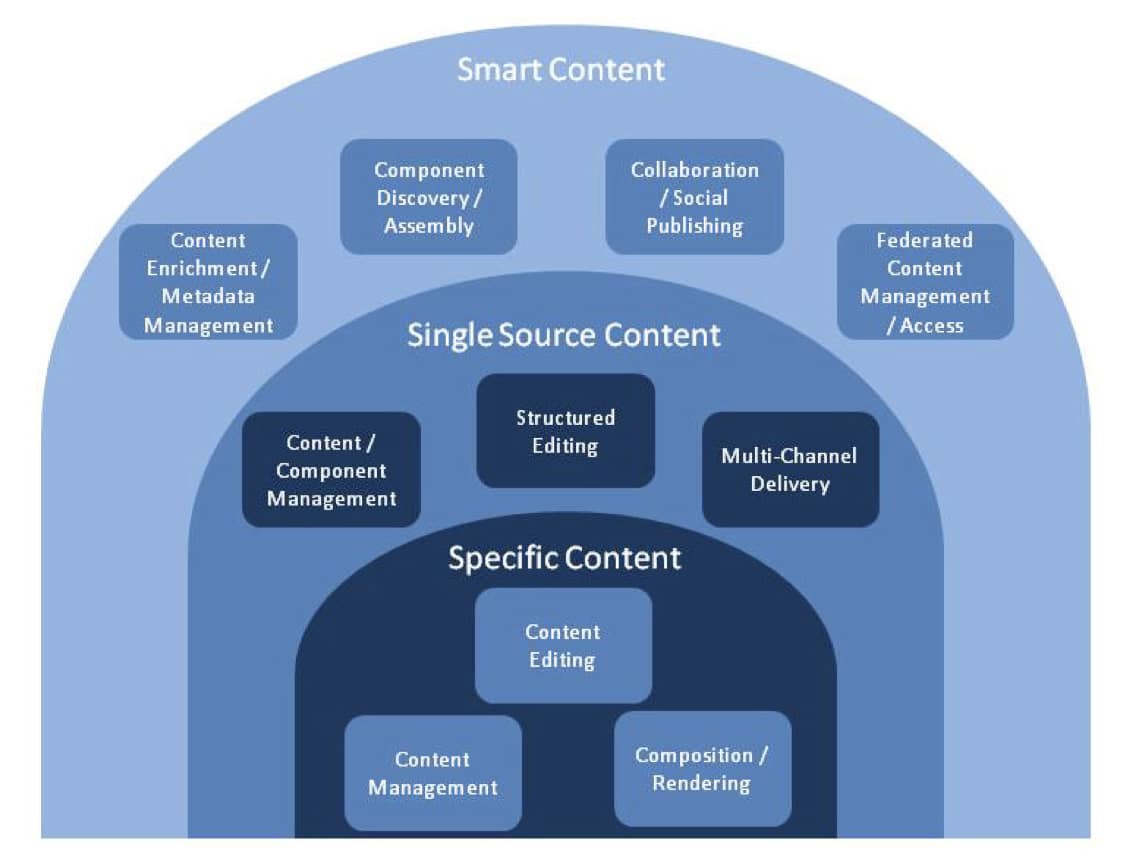If you have been following recent XML Technologies blog entries, you will notice we have been talking a lot lately about XML Smart Content, what it is and the benefits it can bring to an organization. These include flexible, dynamic assembly for delivery to different audiences, search optimization to improve customer experience, and improvements for distributed collaboration. Great targets to aim for, but you may ask are we ready to pursue these opportunities? It might help to better understand the technology landscape involved in creating and delivering smart content.
The figure below illustrates the content technology landscape for smart content. At the center are fundamental XML technologies for creating modular content, managing it as discrete chunks (with or without a formal content management system), and publishing it in an organized fashion. These are the basic technologies for “one source, one output” applications, sometimes referred to as Single Source Publishing (SSP) systems.
The innermost ring contains capabilities that are needed even when using a dedicated word processor or layout tool, including editing, rendering, and some limited content storage capabilities. In the middle ring are the technologies that enable single-sourcing content components for reuse in multiple outputs. They include a more robust content management environment, often with workflow management tools, as well as multi-channel formatting and delivery capabilities and structured editing tools. The outermost ring includes the technologies for smart content applications, which are described below in more detail.
It is good to note that smart content solutions rely on structured editing, component management, and multi-channel delivery as foundational capabilities, augmented with content enrichment, topic component assembly, and social publishing capabilities across a distributed network. Descriptions of the additional capabilities needed for smart content applications follow.
Content Enrichment / Metadata Management: Once a descriptive metadata taxonomy is created or adopted, its use for content enrichment will depend on tools for analyzing and/or applying the metadata. These can be manual dialogs, automated scripts and crawlers, or a combination of approaches. Automated scripts can be created to interrogate the content to determine what it is about and to extract key information for use as metadata. Automated tools are efficient and scalable, but generally do not apply metadata with the same accuracy as manual processes. Manual processes, while ensuring better enrichment, are labor intensive and not scalable for large volumes of content. A combination of manual and automated processes and tools is the most likely approach in a smart content environment. Taxonomies may be extensible over time and can require administrative tools for editorial control and term management.
Component Discovery / Assembly: Once data has been enriched, tools for searching and selecting content based on the enrichment criteria will enable more precise discovery and access. Search mechanisms can use metadata to improve search results compared to full text searching. Information architects and organizers of content can use smart searching to discover what content exists, and what still needs to be developed to proactively manage and curate the content. These same discovery and searching capabilities can be used to automatically create delivery maps and dynamically assemble content organized using them.
Distributed Collaboration / Social Publishing: Componentized information lends itself to a more granular update and maintenance process, enabling several users to simultaneously access topics that may appear in a single deliverable form to reduce schedules. Subject matter experts, both remote and local, may be included in review and content creation processes at key steps. Users of the information may want to “self-organize” the content of greatest interest to them, and even augment or comment upon specific topics. A distributed social publishing capability will enable a broader range of contributors to participate in the creation, review and updating of content in new ways.
Federated Content Management / Access: Smart content solutions can integrate content without duplicating it in multiple places, rather accessing it across the network in the original storage repository. This federated content approach requires the repositories to have integration capabilities to access content stored in other systems, platforms, and environments. A federated system architecture will rely on interoperability standards (such as CMIS), system agnostic expressions of data models (such as XML Schemas), and a robust network infrastructure (such as the Internet).
These capabilities address a broader range of business activity and, therefore, fulfill more business requirements than single-source content solutions. Assessing your ability to implement these capabilities is essential in evaluating your organizations readiness for a smart content solution.



Leave a Reply
You must be logged in to post a comment.